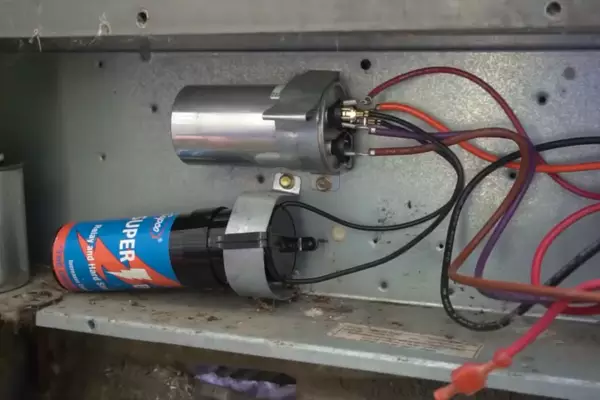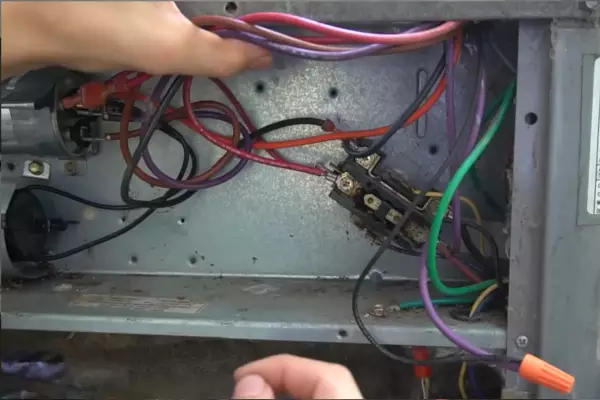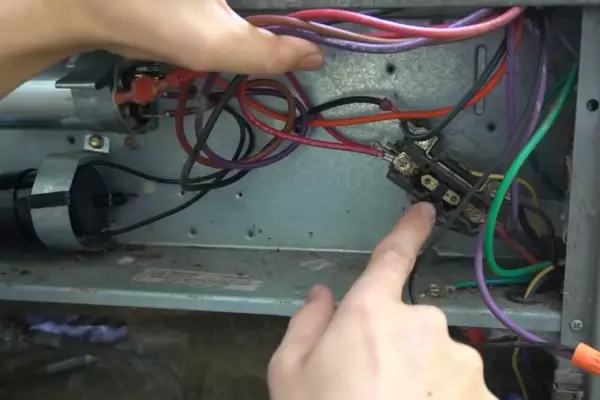Air conditioning units and thermostats share a symbiotic relationship in a home. The thermostat acts as a liaison between the user and the air conditioner, regulating temperature for comfortable living. However, when your AC refuses to work after a thermostat change, it becomes a concern.
Thermostat replacement often arises from a need to modernize your HVAC system or rectify performance decline. But, sometimes, even after replacing an ageing thermostat with a new one, the AC may not function as expected.
Let’s explore the dynamics of this phenomenon, focusing on the post-replacement issues that may cause your AC to malfunction. Identifying these factors will assist in troubleshooting and maintaining an efficient HVAC system.
Contents
AC-Thermostat Mechanics
Thermostat: The Central Command
The thermostat serves as the communication center for your HVAC system. It regulates room temperature by transmitting signals to the AC unit. Therefore, any discrepancy in its functioning can disrupt the AC performance.
AC Response to Thermostat Signals
The air conditioner responds to the thermostat’s cues. If the thermostat signals a need for cooling, the AC starts its cooling cycle. Conversely, once the desired temperature is achieved, the thermostat communicates this to the AC, initiating a halt in the cooling process.

Why Replace a Thermostat
Ageing and Performance Decline
With time, thermostats may start showing signs of wear and tear, impacting their ability to regulate temperature accurately. This performance decline often prompts homeowners to replace their thermostats.
Compatibility Issues
Older thermostats may not be compatible with modern HVAC systems. To leverage advanced features of newer AC units, it becomes necessary to upgrade the thermostat.
Technological Upgrade
With technological advancement, thermostats have evolved to offer features like programmable settings, Wi-Fi connectivity, and energy consumption reports. These modern conveniences can motivate homeowners to replace their existing thermostats.
Possible Issues After Thermostat Replacement
Replacing a thermostat can be a step towards upgrading your HVAC system, but it may also lead to some issues. Here are some common problems that you might encounter after changing your thermostat.
Thermostat-AC Synchronization Errors
One of the key elements in ensuring the optimal functioning of your AC unit is its ability to synchronize with the thermostat. When a new thermostat is installed, the AC unit needs to adjust to the new component.
- This synchronization might not occur as expected if the thermostat has been incorrectly installed, causing the AC to not receive the right signals from the thermostat.
- It can also occur if there are underlying issues with the thermostat itself. It might be defective, or it might not be compatible with your AC unit.
- If you suspect synchronization errors, it might be necessary to seek professional assistance to rectify the problem.
Incorrect Wiring and Installation
Thermostats require intricate and accurate wiring for optimal performance. Improper wiring can disrupt the signals from the thermostat to the AC, causing your AC not to work as expected.
- Incorrect wiring can happen if the wires are not connected to the correct terminals during installation.
- It could also occur if there is damage to the wires, causing them not to transmit the signal effectively.
- Understanding the wiring scheme and following the wiring guide accurately during installation can prevent such issues. If you are unsure, it might be better to hire a professional.
Incompatible Thermostat Type
While thermostats are designed to be universal, not all thermostats work with all AC units. Incompatibility can lead to ineffective communication between the two components and disrupt the normal functioning of your AC.
- You might have an older AC unit that is not compatible with modern, smart thermostats.
- There might be compatibility issues if the thermostat is not designed to work with your specific AC model.
- Always ensure to check the compatibility of your AC unit and the thermostat before making a purchase.
Incorrect Thermostat Calibration
Thermostats need to be correctly calibrated with your AC unit to ensure they provide an accurate reading of the room temperature. If the thermostat is not calibrated correctly, it can cause your AC to over-cool or under-cool your space.
- The thermostat might not have been set to the correct temperature range after installation, causing incorrect temperature readings.
- The placement of the thermostat can also impact calibration. If placed near heat sources, it might provide incorrect readings.
- Follow the user guide of your thermostat for the correct calibration methods and placement guidance.

Detailed Problem Analysis
Understanding the specific issues that can occur after replacing your thermostat can assist you in troubleshooting your AC problems. Let’s delve deeper into each problem and find out their causes and solutions.
Synchronization Errors: Causes and Solutions
Synchronization errors can stem from several factors. Here are some causes and potential solutions:
- Faulty installation: This can occur if the thermostat is not securely connected during installation. Ensure the thermostat is correctly fitted and secure.
- Defective thermostat: If the problem persists despite correct installation, you might have a faulty thermostat. If under warranty, consider a replacement. If not, you might need to purchase a new one.
Wiring Issues: What Can Go Wrong
Incorrect wiring can lead to several issues with your AC’s performance. Here’s what could go wrong:
- Wrong terminals: If the wires are connected to the wrong terminals, the thermostat might not send the correct signals to the AC. Check the wiring scheme to ensure the right connections.
- Damaged wires: Damaged wires can disrupt signal transmission. If you suspect damaged wires, consider replacing them or seeking professional assistance.
Thermostat Type: Ensuring Compatibility
Thermostat compatibility is vital to ensure effective communication with the AC. Here are some considerations:
- Model specific: Some thermostats are designed for specific AC models. Always check for model compatibility.
- Type of AC unit: Thermostats can vary based on the type of AC unit. Ensure to purchase the one suitable for your AC type.
Calibration Issues: Fixing the Setup
Calibration plays a crucial role in the functioning of your AC. Let’s discuss some common issues:
- Incorrect temperature range: Ensure to set the thermostat to the correct temperature range as per your comfort.
- Wrong placement: The thermostat should be placed away from heat sources for accurate temperature readings.

Professional Help vs DIY
When to Call a Professional
Seek professional help when the thermostat replacement seems complicated, or the AC continues to malfunction post-installation. They have the expertise to identify and fix the issue accurately.
The Risks of DIY Solutions
While DIY installations can save on costs, they carry the risk of incorrect installation or damage. Without proper knowledge, homeowners may struggle to troubleshoot post-installation issues effectively.
Cost-Benefit Analysis
Though professional services incur expenses, they save on potential damages and ensure optimal functioning of the HVAC system. DIY installations, while cost-effective, may prove costly in the long run if mishandled.
Preventive Measures
Regular Thermostat Maintenance
To avoid AC issues post-thermostat replacement, regular thermostat maintenance is crucial. This ensures it functions optimally and communicates effectively with the AC.
Professional Installation and Calibration
Professional installation and calibration ensure the thermostat and AC are in sync. This step mitigates the risk of AC malfunction post-replacement.
Proper AC-Thermostat Matching
Ensure that the AC unit and the thermostat are compatible. Incompatibility can cause the AC to malfunction despite a successful thermostat replacement.
Frequently Asked Questions
Why is my AC not turning on after replacing the thermostat?
Your AC might not turn on due to incorrect wiring, incompatible thermostat, or faulty installation. You might need to check the wiring, ensure thermostat compatibility, or seek professional assistance.
Can a thermostat cause the AC not to work?
Yes, if a thermostat is faulty, incorrectly installed, or incompatible with the AC unit, it can disrupt the AC’s functioning.
How can I check if my thermostat is working correctly?
Check the display, ensure it’s correctly programmed, and note if it’s regulating temperature as per the settings. If there are discrepancies, you might need to seek professional help.
Conclusion
In a home HVAC system, the thermostat plays a pivotal role in maintaining a comfortable environment. Its efficient functioning and synergy with the AC unit are paramount for optimal cooling.
Replacing an ageing or incompatible thermostat can enhance your HVAC system’s efficiency. However, it’s crucial to ensure correct installation, compatibility, and calibration to avoid post-replacement issues leading to AC malfunction.
This exploration of AC-thermostat dynamics, potential post-replacement problems, and their solutions offer insights for homeowners dealing with a similar situation. Understanding these factors can assist in maintaining a reliable and efficient HVAC system, fostering a comfortable living space.

